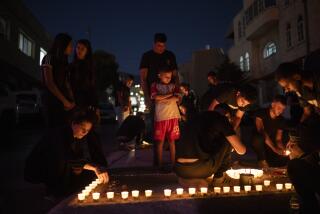Checklist for Cheney and Powell: Mission, Enemy, Terrain and Troops : Tactics: The answers they get will determine when--and if--the battle is joined in the trenches.
- Share via
President Bush announced that Secretary of Defense Dick Cheney and Gen. Colin L. Powell, chairman of the Joint Chiefs of Staff, will be going to Saudi Arabia at the end of this week.
With a possible ground campaign looming in the Persian Gulf War, the two men will be there to get answers to a myriad of questions.
What will drive their thinking when they confer with the U.S. commander, Gen. H. Norman Schwarzkopf, and other commanders in the theater? What will be their framework for analysis? What kinds of things will these senior defense officials consider? What factors will influence their recommendations to the President?
Far from trying to rush into battle, Powell and Schwarzkopf from the beginning have counseled patience and a slow but sure approach. Rather than being jealous of the air campaign, as some have suggested, as the approving authorities in the chain of command they, in fact, have made such a campaign possible. Both are combat infantry veterans who know firsthand how bloody a ground war can be. They would be more than happy if the air campaign were to force the surrender of the Iraqi army, making a ground campaign unnecessary.
But, while all allies hope the air war will suffice, a ground campaign must be considered likely to occur. And that’s what the forthcoming meeting in Riyadh is all about.
What factors will shape their considerations? As a fellow graduate of the Infantry School at Ft. Benning, Ga., I know one acronym that will be on the minds of Powell and Schwarzkopf: METT--mission, enemy, terrain, and troops available.
War is fought simultaneously on three levels: strategic, operational and tactical.
At the strategic level, the task is to conduct military operations to achieve or assist in achieving the political objectives of the United States. At this level another ‘T’--for time--is often added, and may be, as at the beginning of the Gulf War, the controlling factor.
Reports that Bush--fearing the allied coalition could not survive long without action after the Jan. 15 U.N. deadline for Iraq’s withdrawal from Kuwait--ordered the war to begin a month before his commanders would have preferred, have the ring of truth to me. When it comes to the commencement of the ground war, however, time does not appear to be the deciding factor. Instead, military factors will dominate.
First among them is the mission to be accomplished. At the operational level--i.e., the theater of war level--that task seems clear. Conduct ground operations to breach enemy defenses along the Saudi-Kuwaiti border and drive the Iraqi army out of Kuwait. On the face of it, such military action would seem to accomplish U.S. strategic political objectives--ejection of Iraqi military forces from Kuwait and restoration of its government.
But, in fact, that may not be the case. If Saddam Hussein decides to continue to fight (as North Korea’s Kim Il Sung did after his army was ejected from South Korea in 1951), there could be the kind of battlefield stalemate that plagued the United States in the Korean War. This seeming contradiction between military and political objectives should be one of the major topics discussed and determined, for it may require a change in either the political or military missions. Either the political objective should be changed to include the destruction of the Iraqi armed forces and the elimination of Hussein, or it must be recognized that the war cannot be ended by military means and a negotiated settlement will be required.
The second factor is the enemy himself. How badly is he being hurt by the bombing campaign? How much further damage can be inflicted on his military forces in the field by air attack alone? How good is the allied bomb damage assessment? When will the battlefield change (to use military jargon) from a “target-rich” to a “target poor” environment? What are his strengths and weaknesses? Is he most vulnerable to an envelopment (that is, sweeping around his flanks with armored columns) or to a penetration attack (busting a hole through his fortifications)?
Terrain is the third factor. How vulnerable to air attack are his desert fortifications? Have they collapsed under allied bombing? Can the allies punch a hole through them using air attack alone?
Can the United States launch an amphibious assault against the Kuwaiti coast? How well can tanks and trucks traverse the desert along likely attack routes?
Finally, there is the issue of troops available. Reports are that the final shipment of U.S. M-1A1 Abrams tanks is due in Saudi Arabia this week. Are there now enough allied troops and equipment to do the job? Is there enough ammunition? Enough spare parts? Are allied troops as trained and ready as they can be? Have they moved forward into their attack positions?
Those will be the kinds of questions discussed in Riyadh this week. The answers will determine when--and if--the ground campaign begins.
More to Read
Sign up for Essential California
The most important California stories and recommendations in your inbox every morning.
You may occasionally receive promotional content from the Los Angeles Times.













